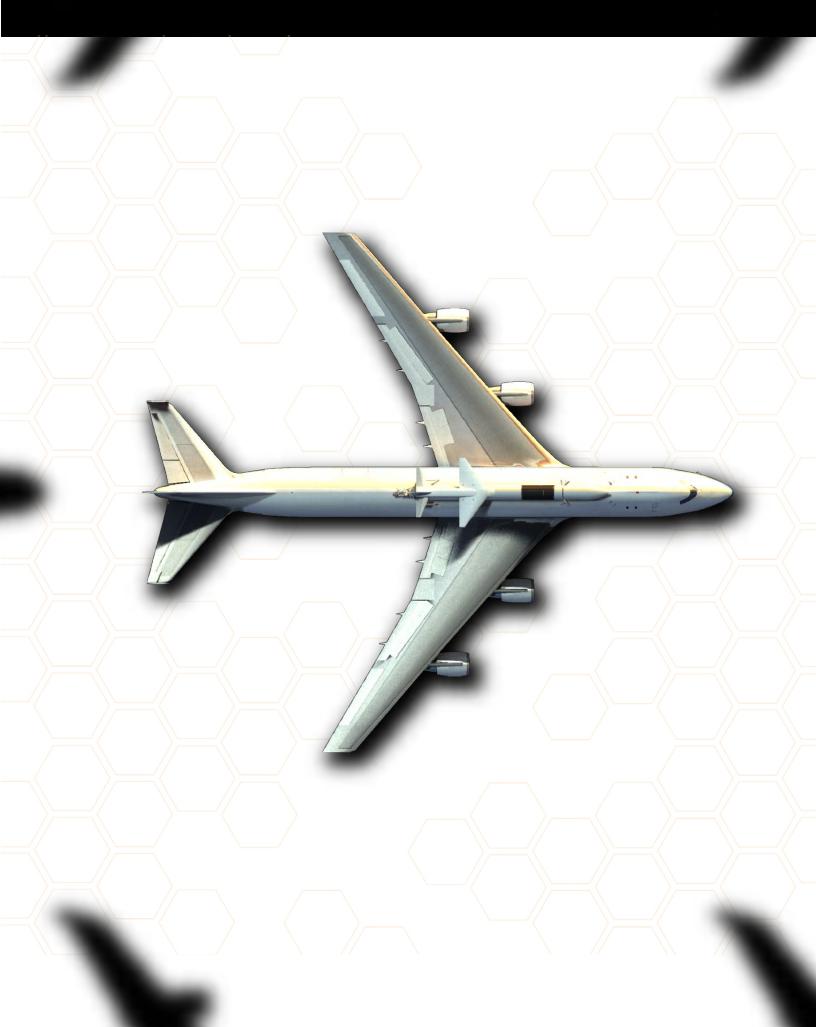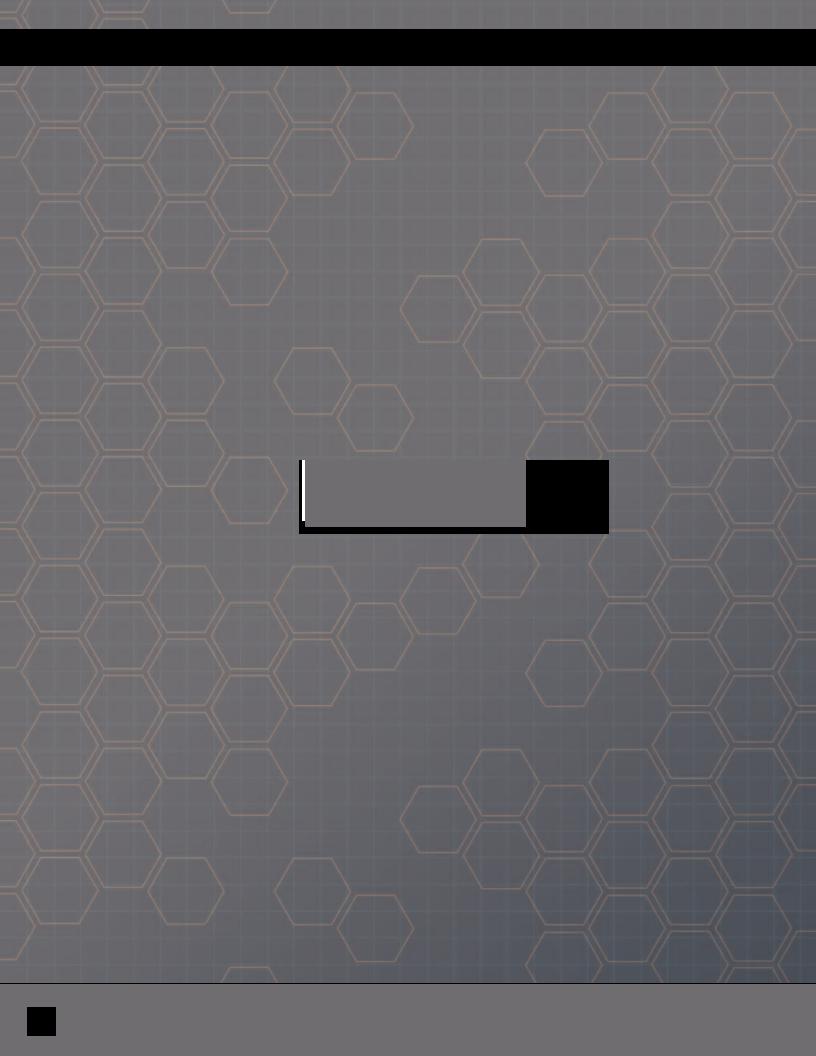
Horizontal_Launch_-_a_Versatile_Concept
.pdf
Summar y of Resul t s
The first major uncertainty was launch vehicle separation. This could be reduced to a limited extent by modeling and wind tunnel tests. Accurate characterization of the aerodynamic inter- actions between the carrier aircraft and launch vehicle would, however, require flight tests. These tests would also include inert separation flights to validate separation simulations utilizing a dummy launch vehicle identical in size and mass distribution. This would be used to calibrate separation analysis to ensure a clean separation prior to launching a fully fueled launch vehicle.
The second major uncertainty was in-flight command and control. The most important benefit of horizontal launch was the ability to launch a payload from anywhere in the world without significantgroundsupportinfrastructure.Thiswouldrequireanin-flightcommandcenterthat was capable of observing and predicting downrange weather conditions, winds aloft, and air traffic. This system was not only necessary for the structural integrity of the launch vehicle but was critical to assure accurate orbit insertion for mission success.
The third major uncertainty was cryogenic handling and storage. The complexity of the fuel transfer arrangement creates the potential for boil-off and leakage through normal operation, withaheightenedriskfromhumanerrorofequipmentfailure.Suchasystemrequiresintensive monitoring and control during storage and transfer. Reliable structures for containment tanks are critical, as are all materials at cryogenic temperatures.
In addition to addressing these three major uncertainties, well-designed flight testing would also validate and optimize the models used for aerodynamics, carrier aircraft and launch vehicle control, structural loads, and overall system performance. It would be critical to carry out this validation prior to beginning a significant design and development program.
Flight tests were also critical to demonstrate operability factors including turnaround time, crew size, launch vehicle integration, ground and in-flight cryohandling, in-air propulsion start, and on-board mission and flight control. Current launch costs (assuming the full payload capa- bilitywasusedforeach)rangefrom$30,000perpoundforthePegasus,to$5,000to$8,000per pound for evolved expendable launch vehicles, and to $2,500 per pound for a Falcon 9. The factors that drive this large range include approaches to hardware acquisition, system integra - tion, test and evaluation, and mission planning. A solid understanding of all of these factors would be needed to respond to the requirements of a new DRM.
TherecurringlaunchcostsfortheSpaceShuttle—anaverageof$13,000perpoundofpayload— reveal an opportunity: only 9 percent of the cost was accounted in hardware acquisition, inte- gration, and system turnaround, and only 22 percent was in indirect system support. The majority, almost 70 percent, was attributed to management support. Thus, a key driver for any planned flight test was to demonstrate a change to the traditional processes that contrib- uted to the staggering overhead burden. These will include changes not only to management oversightmethods,buttoqualitycontrol,logisticssupport,trafficandflightcontrolapproaches, and launch and support infrastructure.
A v er sat ile concep t for a ssur ed space access |
|
|
67 |
|
|
|
|
|
|
|
|

Chapter 8
68 Horizontal l aunch

CHAPTER 8
FUTURE SYSTEM CONCEPT STUDIES
This study was intended to provide the foundation, both through the historical review and the integrated analysis, to aid in defining requirements for any future horizontal launch vehicle system development program. A number of design decisions can be informed by this analysis, including launch rate, separation speed of the carrier aircraft, and technology development.
Other factors, such as orbit altitude, launch location, and carrying crews to orbit warrant more attention than has been provided here.
The most important factor affecting recurring costs was launch rate, and cost remains the biggest challenge to widespread adoption of horizontal launch. This HLS team, therefore, believes this will drive a concept with the versatility to accommodate many different missions. A successful horizontal launch enterprise should encompass both military and commercial users across a wide range of payloads.
A successful enterprise may also be designed to span inclinations and altitudes from low to geosynchronous orbits. The reference mission systems used in this study, a capability to launch 15,000lbtoLEOat100nauticalmiles,willnotbeabletolaunchthesamepayloadmasstogeosyn- chronous orbit (GEO) at over 22,000 nautical miles. The same system may, however, be capable of launching a smaller payload, roughly one third the size, to GEO.
The ability to launch from a number of global launch sites will clearly be one of the most impor- tant factors from the perspective of both commercial and military users. However, by over-spec- ifying payloads, fuels, orbit inclinations, altitudes, abort scenarios, or airspace restrictions, users could unnecessarily limit the development of a launch system concept.
The opportunity for the horizontal launch of crews or tourists to orbit also warrants consider- ation. This study showed a horizontal launch system concept with ideal subsystem sizing could launch a 20,000 lb payload to LEO. It remains a subject for future studies as to what decrease a human-rated horizontal launch system would take compared to the baseline.
Perhaps the most important factor in any system development was choosing the right technology availability date for critical subsystems and component technologies. Many design and devel- opment programs in the past have failed to meet operational requirements because they were overly optimistic on the availability of new technologies. It was extremely important to confirm and demonstrate the technology readiness when selecting and specifying technologies. It was also critical to make the needed technology investments in a timely manner once an implementa- tion was planned.
TechnologyAdvanced technologiesDemonstrationsthat increase system level performance, decrease maintenance down time, and reduce costs will have to “buy their way in” after initial operations of the horizontal launch system. To do this, these technologies will have to be validated at operating conditions for the application (as specified to achieve TRL 6). Those technologies with potential for improved
A v er sat ile concep t for a ssur ed space access |
|
|
69 |
|
|
|
|
|
|
|
|

Chapter 8
operations, increased system level performance, or lower costs would go through a rigorous ground test validation prior to incorporation into a flight test evaluation program.
Flight test validation could be accomplished on the actual operating system but that would increase the risk of grounding the operational system. A better way may be to continue to operate the flight test demonstrator as a flying test bed. While the flight test demonstrators identified in this study do not satisfy the 15,000 lb payload goal, they should be effective in reducing major uncertainties and risks associated with horizontal launch. If a candidate technology was deemed through systems analysis to be low risk, it may make sense to launch as a nonprimary system on an operational vehicle. Once the technology passes through all of these gates, the design engineer can use it in a scheduled block upgrade of the horizontal launch system.
The list of conceivable technologies considered was limited in this study. It was not the intent of this study to include every potential technology improvement, but to identify the value of technol- ogiestoupgradetheexpendablehorizontallaunchvehiclesystemconcept.TheHLSteamconsid- ered the full impact of a given technology for this particular set of requirements—including payload performance, ground and flight operations, reliability, and costs. When subjected to this broad analysis, it became apparent that some initially attractive technology benefits did not warrant investment at this time. Many of these technologies may offer value in other instances, in particular for horizontal launch applications that employ reusable hardware, or if they provide benefits to multiple systems.
AlternateIn addition toCapabilitiesthe traditionalforpayloadHorizontallaunchLaunchcapabilitySystemsto low Earth orbit missions that hori- zontal launch systems can provide, a number of other suborbital, largely NASA and DoD unique, technology demonstration or potentially operational capabilities may be enabled or strongly enhanced by these types of systems. As examples, NASA’s Office of the Chief Technologist has recentlysponsoredthedevelopmentofaseriesofSpaceTechnologyRoadmaps,whichdefinenew and innovative technology capabilities and investment recommendations spanning a 20-year development cycle.4
Forexample,hypersonicairbreathingpropulsiontechnology,whilenotcurrentlymatureenough for use in near term horizontal launch systems was a key element of the Launch Propulsion Space TechnologyRoadmapandhasmanyelementsthatwillrequirematurationthroughflighttesting. ThetechnologiesincludedintheroadmapincludeMach4+turbinesforTBCC,long-durationMach 7+ scramjet operation, stable mode transitions of RBCC and TBCC vehicles, ACES, and detonation wave engine operation. Each of these component level technologies will require extensive ground tests and certification at the component level, and will ultimately require flight testing and quali- fication of these systems at or near full scale.
4A total of 15 draft technical area (TA) roadmaps cover a broad range of technology disciplines and capabilities. The TA-01 “Launch Propulsion Systems” and TA-09 “Entry, Descent, and Landing” roadmaps explicitly call out the need for advanced flight test capabilities to develop new and innovative technologies to transform our space transportation infrastructure. Available at: http:// www.nasa.gov/offices/oct/home/roadmaps/index.html
70 Horizontal l aunch

Future Sys tem C oncept Studies
The availability of a horizontal launch platform to deliver large scale advanced air breathing propulsiontechnologydemonstrationelementstohighenergy(i.e.,highMach,highq)suborbital test conditions could result in greatly enhanced flight test capabilities. Much like the modified the Pegasus launch vehicle did for the subscale X-43A scramjet vehicle flight test, such a capability could enable qualification of engine and vehicle system technologies at much lower cost and risk. The current fleet of suborbital sounding rockets was performance limited in the volume and scale of their payloads and only have limited capabilities for payload delivery in suppressed altitude trajectory flight tests. The rocket launch systems evaluated in this study—Falcon or Taurus—could be modified to perform the suborbital suppressed trajectory missions required. However, they were not currently designed to carry large horizontal launch loads, and signifi- cant requalification would be required. An air-launched horizontal launch system, designed to accommodatethesetypesoftrajectoriesandloads,wouldrequireonlystraightforwardmodifi- cations to support these flight test missions.
With current component-level engine ground test articles and X-43A and X-51 flight demon- strations defined as “1x scale”, the hypersonics project in NASA’s Aeronautics Research Mission Directorate, calls for a 10x and ultimately a 100x scale engine and vehicle systems technologies that will need to be flight qualified. The horizontal launch systems described here would likely be capable of testing support to the 10x level system scale in a manner similar to how Pegasus supported testing X-43A at the 1x scale.
By allowing the new engine component technologies to be boosted and flight tested as indi- vidual elements to their requisite test conditions on a standalone carrier vehicle, the need for a full-scale integrated flight system development testing using an airbreathing propelled test vehicle with low-speed and high-speed propulsion cycles may not be necessary. This could allow for multiple advanced high speed propulsion system technology developments to occur in parallel, or staggered over a period of years and development cycles, and then removed indi- vidually from the critical path in an airbreathing flight vehicle system. The technologies could be developed and qualified individually, and only after qualified and flight proven at the compo- nent or subsystem level would they be integrated on a dedicated airbreathing launch vehicle flight system. A number of other advanced launch system technologies, not directly propulsion system related, could be tested at or near full scale including boundary layer and turbulent tran- sition experiments, warm and hot structure, actively and passively cooled, thermal protection systems, and so on.
In addition to hypersonic airbreathing propulsion, flight test demonstrations and launch capa- bilities were needed that exceed today’s state of the art with sounding rockets and balloon launch rocket assist systems. These include multiple technologies, ranging from hypersonic and supersonic inflatable aerodynamic decelerators, rigid and flexible deployable aerodynamic decelerator systems, new slender body entry aeroshells with high performance maneuvering capabilities, to supersonic retro-propulsion for large mass payload descent systems at Mars. For many of the human scale entry, descent, and landing (EDL) systems, and even some of the large robotic EDL technologies, the mass and volume requirements far exceed capabilities that existwithsuborbitaltestplatformstoday.Allofthesewillultimatelyrequireflighttestingator near full scale.
A v er sat ile concep t for a ssur ed space access |
|
|
71 |
|
|
|
|
|
|
|
|

Chapter 8
In order to fully qualify these systems, they must be tested in a relevant environment at or near full scale. In the late 1960s and early 1970s, NASA developed a supersonic parachute technology for the Mars Viking mission. In order to test the Viking parachutes at relevant Mars conditions, a flight test capability was developed that utilized high altitude balloons that carried a rocket propelled launch systems to altitudes of approximately 100,000 feet. The payload was severed from the balloon at altitude and rocket propelled to supersonic conditions. While this type of capability can still be utilized, it was severely limited in mass and volume capabilities, and would not be capable of delivering the large scale human class or robotic precursor decelerator system technologies to the high altitude high Mach number conditions require for full or nearfull scale qualification and flight certification. Notional examples of several of these advanced EDL system technologies are shown in Figure 8.
Payload Delivery
Figure 8 A flight test demonstrator can provide suborbital depressed trajectory launch capability for unique high q/high Mach systems technology demonstrations.
72 Horizontal l aunch

Future Sys tem C oncept Studies
|
|
|
|
|
|
|
|
|
A v er sat ile concep t for a ssur ed space access |
|
|
|
73 |
|
|
|
|
|
|
|
|
|
|

Appendices
74 Horizontal l aunch

APPENDIX A
FIGURES OF MERIT
Figure of Merit |
Definition |
Measures |
Proxy Parameters |
|
|
|
|
Safety and mission success |
|
|
|
Loss of vehicle |
Probability of a critical |
P(Loss of Vehicle) |
Number of engines; inherent reliability |
probability, by |
failure occurring |
|
and redundancy strategy of engines and |
stage |
resulting in loss of stage |
|
other subsystems; stage complexity; |
|
|
|
emergency stage separation complexity; |
|
|
|
number of stage return options |
Loss of mission |
Probability of a critical |
P(Loss of Mission). |
Number and type of system risks and |
probability |
failure occurring |
|
mission hazards; subsystem inherent |
|
resulting in loss of one |
|
reliability; system/subsystem functional |
|
or more major mission |
|
redundancy (e.g., engine-out capability); |
|
objectives |
|
number and complexity of stages; |
|
|
|
number of engines and stages; total |
|
|
|
mission duration. |
|
|
|
|
Effectiveness and performance |
|
|
|
Payload |
Compatibility |
Payload weight |
None |
|
of payload |
delivered to LEO; |
|
|
accommodations for |
payload volume; |
|
|
commercial and military |
payload services |
|
|
missions |
|
|
Minimum |
Minimum time needed |
Operational |
System complexity; mean time between |
turnaround time |
between mission |
readiness after |
maintenance; Stage integration |
|
completion and mission |
mission completion |
complexity; Propellant safeing |
|
ready |
|
|
Surge call-up time |
Time between the |
Time to launch after |
Complexity of payload integration; |
|
announcement of a |
operational readiness |
time to fill tanks; launch checkout time; |
|
surge mission need and |
|
mission software load time |
|
launch |
|
|
Basing flexibility |
The ability to launch |
System on-ground |
Propellant type, system and subsystem |
|
from various launch |
safety, takeoff and |
maturity, wing loading. |
|
sites and airports |
landing requirements |
|
Mission flexibility |
The ability to adapt to |
Mission flexibility |
Aspect ratio, specific fuel consumption, |
|
mission requirements. |
(crossrange, |
mass ratio, propellant type |
|
|
downrange, loiter |
|
|
|
time, cruise margin, |
|
|
|
payload weight and |
|
|
|
volume) |
|
Military viability |
Unique mission |
Qualitative |
DDT&E costs; fixed and variable recurring |
|
capability for |
assessment of |
cost; flight rate; payload capability |
|
investment cost |
military viability |
uniqueness; system launch mobility; |
|
|
|
system launch availability; system |
|
|
|
turnaround time |
|
|
|
|
Factors quantitatively calculated
Factors qualitatively determined using expert elicitation
A v er sat ile concep t for a ssur ed space access |
|
|
75 |
|
|
|
|
|
|
|
|

A pp endix A
Figure of Merit |
Definition |
Measures |
Proxy Parameters |
|
|
|
|
Programmatic Risk |
|
|
|
Failure to achieve |
Likelihood of |
Risk exposure |
Number of critical subsystems at TRL |
DDT&E goals |
development activities |
score using five- |
7 or below; number and type of large- |
|
to exceed schedule |
level qualitative |
scale integrated ground demonstrations |
|
and budget constraints |
assessment of |
required; number and type of flight tests |
|
and consequence of |
likelihood and |
required |
|
occurrence |
consequences |
|
|
|
of development |
|
|
|
maturity and |
|
|
|
complexity of |
|
|
|
major subsystems; |
|
|
|
total risk exposure |
|
|
|
= (likelihoodi x |
|
|
|
consequencesi) |
|
Failure to achieve IOC |
Date of projected initial |
Technology |
Lowest TRL of the most critical |
date |
operating capability |
development time, |
subsystems; projected technology and |
|
(IOC) |
system DDT&E time |
development time; Criticality of mission |
|
|
|
needs. |
Technology maturity |
Likelihood of |
TRL6 or above |
Number of technologies required; |
|
architecture DDT&E |
|
average TRL of technologies; average |
|
activities to exceed |
|
RD3 score of technologies; number and |
|
planned schedule |
|
type of large-scale integrated ground |
|
and consequence of |
|
demonstrations required; number and |
|
occurrence |
|
type of flight tests required |
Commercial |
Ability to establish and |
Estimated lifecycle |
Price and projections of existing launch |
viability |
serve a sustainable |
cost below price of |
systems |
|
business base |
existing or planned |
|
|
|
launch options |
|
|
|
|
|
Affordability |
|
|
|
Cost of DDT&E |
Cost to design, develop, |
DDT&E costs; peak |
|
test, and evaluate all |
annual cost |
|
architecture elements |
|
|
prior to IOC |
|
Total inert mass; Number and level of complexity of architecture systems; number of interfaces between major architecture elements/systems; percent of new hardware and hardware that uses new technologies used in architecture systems; management and acquisition approaches used in the development of architecture systems
Cost of facilities |
Cost to establish new or |
Facilities costs; |
|
modified facilities (e.g., |
ground support |
|
manufacturing, launch, |
equipment costs; |
|
processing, propellant |
peak annual costs. |
|
production) needed to |
|
|
conduct missions. |
|
Cost of acquisition |
Unit cost of acquiring |
Unit production |
and production |
or producing all carrier |
costs |
|
aircraft, launch vehicle |
|
|
stages, aerosurfaces, |
|
|
and fairings |
|
Total volume and mass of facilities required; Level of complexity of facilities; Percent of new hardware and hardware that uses new technologies used in facilities; Management and acquisition approaches used in the development of new facilities
Inert mass, system complexity
Factors quantitatively calculated
Factors qualitatively determined using expert elicitation
76 Horizontal l aunch
